Over time, moisture contamination in an A/C system will form corrosive acids that attack metal surfaces and break down the lubricating qualities of the compressor oil. The result is a dark-colored sludge called “Black Death” that can gum up the orifice tube or expansion valve and ruin the compressor.
How does moisture get in the system? Humidity in the air can slowly infiltrate microscopic pores in seals and hoses over time (we’re talking years, in most cases). But a refrigerant leak due to a bad seal, hose or hose connection, or a pinhole leak in the evaporator or condenser can allow air and moisture to seep in as refrigerant leaks out. Moisture can also contaminate the system very quickly if the A/C system is discharged and a hose is disconnected and left open for more than a few hours (which often occurs when repairs are made). The higher the relative humidity, the faster the rate of contamination when the system is left open.
Another source of moisture contamination can be bad refrigerant. Virgin refrigerant contains no air or moisture. Neither does recycled refrigerant, provided it is recycled properly and the recycling equipment is maintained and working correctly. But if there’s a problem with the recycling equipment, the filters haven’t been replaced or the storage tanks have not been purged, residual moisture from one vehicle can be passed to the next via the recycled refrigerant. Consequently, if the A/C system is recharged with bad refrigerant, it’s doomed from the get-go.
Protecting Against Possible Black Death
A/C systems do have a limited amount of built-in protection against moisture contamination. It’s called desiccant. The desiccant consists of moisture-absorbing crystals in a small bag or pouch inside the accumulator or receiver-drier. The desiccant can absorb and hold up to several ounces of moisture, which is adequate to protect the system under normal conditions. But it isn’t enough to protect the system if there is a refrigerant leak or if a hose is left open overnight. That’s why you should recommend replacing the accumulator or receiver-drier if the A/C system has had a moisture contamination problem.
Most of the moisture that enters an A/C system through an open hose during normal service procedures can be removed by vacuum purging the system prior to recharging it with refrigerant. This step is something every professional technician should do prior to recharging an A/C system because it pulls out both air and moisture. You don’t want air inside an A/C system because it displaces refrigerant and reduces cooling efficiency. Air also makes the compressor work harder and run hotter. This can make the system noisy and may eventually lead to premature compressor failure.
Vacuum purging requires pulling a high vacuum (29” Hg) on the system and leaving it under the vacuum for 30 minutes to an hour or more (longer is better in areas of high humidity). Even then, there may be some residual air and moisture that remains trapped in the compressor oil. But as long as most of the air and moisture are pulled out, it should cause no problems.
CARB Proposing Ban on Sale of Automotive Refrigerant to Consumers
Sacramento, CA — The California Air Resources Board (CARB) has proposed a law to ban the sale of R-134a refrigerant to consumers, potentially impacting the ability of California DIYers to work on their cars. If enacted, Californians will no longer be permitted to purchase cans of auto refrigerant, leaving them with no option but to go to a repair facility for assistance, according to a group opposing the proposed ban.
A new coalition called “Stay Cool California” has formed to help fight the proposed law. “Stay Cool California” says the ban “targets the very people who can least afford to have this service performed at a repair shop and places an economic burden upwards of $167 million on fixed and lower income Californians.”
“Instead of going after oil companies and utilities that emit millions of tons of greenhouse gases, the California Air Resources Board is aiming its regulatory guns on consumers who prefer to work on their own cars,” stated Tom Brown, a coalition spokesperson. “What costs consumers $10 today for a can of auto refrigerant, will cost them $150 or more tomorrow if CARB gets their way. That’s just not fair for those people who cannot afford to take their car to a repair shop to have this very simple and necessary service done.”
“Stay Cool California” has launched a website, www.staycoolcalifornia.com to motivate consumers, auto enthusiasts, hobbyists and do-it yourselfers in opposing the proposed consumer ban.
“We understand the need to reduce global warming in California and the members of our coalition are committed to doing this. But targeting low and fixed income Californians is no way to reduce global warming and is unfair and discriminatory. CARB should be going after sources where more substantial greenhouse gas emissions can be achieved at much lower cost to the citizens of California real greenhouse gas emissions reductions,” Brown added. Feedback: We’d like your opinion. Do you think that DIYers or non-certified technicians should be banned from buying R-134a refrigerant? E-mail us your comments at [email protected].
CARQUEST, MACS Seek A/C-Heat Tech of the Year
Lansdale, PA — CARQUEST and the Mobile Air Conditioning Society (MACS) Worldwide have teamed up to find the best mobile air conditioning and heat transfer service technician in North America. The winner will receive a prize package that includes the opportunity to participate in the opening ceremonies at the CARQUEST 300 in Charlotte in May 2008.
Technicians who are certified in refrigerant recycling and recovery may sign up now at www.carquest.com/macs to participate in a series of written and hands-on skill assessments to test their mobile A/C and heat transfer service knowledge.
The winner of the CARQUEST-MACS technical skills competition will be announced at the keynote luncheon sponsored by CARQUEST at the MACS Worldwide 28th annual Convention and Trade Show, Jan. 31 through Feb. 3, 2008 at Disney’s Coronado Springs Resort in Orlando.
Refrigerant Developers Join Forces for new Formulations
DuPont and Honeywell are joining forces to accelerate the development and commercialization of next generation, low global warming refrigerants for the automotive air conditioning industry.
Under the agreement, DuPont and Honeywell will jointly identify, develop, test and qualify new low global warming potential (GWP) refrigerants that are cost-effective alternatives to other technologies being considered by the auto industry. Automakers are currently evaluating mobile A/C systems that use such technologies. Ideally, automakers are seeking a commercially viable fluorinated gas solution that is compatible with conventional HFC-134a mobile air conditioning system technology and offers a more cost-effective industry transition versus CO2 technology.
The two companies say the new refrigerants would enable automakers to meet new regulations in Europe that require the use of low GWP refrigerants in mobile air conditioning applications. The new regulation is scheduled to take effect in 2011 for new model automobiles, with the transition complete by 2017.
According to industry estimates, there are more than 400 million cars with air conditioning systems globally, with each system using between 1 to 2 lbs. of refrigerant. Air conditioning systems utilizing fluorine-based refrigerants, such as those Honeywell and DuPont are seeking to develop, are more energy efficient than CO2-based air conditioning systems, particularly at high ambient temperature conditions. Based on a test conducted by DuPont comparing mobile A/C systems utilizing DuPont’s low GWP replacement refrigerant and CO2, widespread utilization of a fluorine-based refrigerant could lead to worldwide emissions reduction equivalent to 230 million gallons of fuel per year by 2017.
For additional information, visit www.honeywell.com or www.dupont.com.
A/C Service Tip: Noisy Nissan
If a customer at your shop indicates that a light ticking or humming noise can be heard coming from the blower motor of his/her Nissan (see affected vehicles) when the motor is run at low fan speeds (speed 1 or 2), a noise-reducing blower motor is available. The noise may be very slight and, at times, difficult to hear.
Affected Vehicles:
1996-2001 Pathfinder (R50);
1995-’99 Maxima (A32);
2000-’01 Maxima (A33) with automatic heater/air conditioner controls.
Service Procedure
Run the blower motor at low fan speed (speed 1 or 2) and evaluate the noise. Decide which category the noise falls under:
Loud rattle, clatter, jolt or flap: go to the procedure for blower case cleaning.
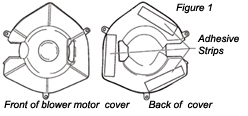
Light ticking or humming noise: complete the following steps to install a new blower motor cover.
Remove the instrument panel lower cover (if equipped).
Disconnect the blower motor harness connector.
Clean the blower motor housing to ensure adhesive strips on the back of the blower motor cover will stick (standard window cleaner can be used).
Note: Be sure to remove all residual film from the blower motor housing that may have been left by cleaning.
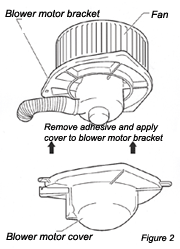
Peel the protective coverings from the adhesive strips on the blower motor cover. See Figure 1.
Install the blower motor cover onto the motor bracket.
Reconnect the blower motor harness connector.
Reattach the instrument panel lower cover (if equipped).
Run the blower motor at low fan speed. Confirm that the blower motor is working properly and the noise is eliminated or reduced to an acceptable level.
Blower Case Cleaning:
Remove the blower motor unit from the blower case.
Remove all foreign material from the case.
Reinstall the blower motor unit.
Technical service bulletin courtesy of Mitchell 1.
A/C Service Tip: A Saturn Freeze Up
By Rich Diegle, contributor
Saturn, the sixth planet from the Sun and the second largest in our solar system, boasts winds near its equator, that reach velocities of 1,100 miles an hour. The temperatures of Saturn’s cloud tops consistently drop down to -285° F (-176° C). I don’t think Saturn will ever become one of those trendy, futuristic vacation planets.
Speaking of vacations… during their real vacations, 1994 Saturn (the car) owners may have experienced an annoying air conditioning problem. Unlike Saturn (the planet), their A/C stopped blowing cold air. And the strange thing was, when driving around town, the A/C worked fine.
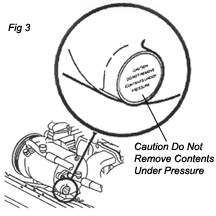 This problem still plagues 1994 and newer Saturn models, equipped with an R-134a air conditioning system. The core of the problem is an A/C compressor suction set point that could be too low for some customers’ usage and driving patterns. This condition results in complete evaporator freeze-up after extended periods of highway driving.
This problem still plagues 1994 and newer Saturn models, equipped with an R-134a air conditioning system. The core of the problem is an A/C compressor suction set point that could be too low for some customers’ usage and driving patterns. This condition results in complete evaporator freeze-up after extended periods of highway driving.
Service Procedure
The first thing to do is confirm with the customer that their A/C system functions normally in all conditions except extended driving at highway speeds. If so, adjust the A/C compressor set point using the following procedure.
Note: The engine does not need to be running for the A/C compressor set point adjustment.
Locate the setscrew on the rear head of the A/C compressor.
Important Note: The setscrew will be covered with either a solid silver label or a silver label with the words: “Caution: Be careful to keep hands clear of the engine cooling fan.
The engine cooling fan may operate unexpectedly.” See Figure 3. If the silver label has been broken, or an orange replacement label is present, do not continue with this procedure. Additional adjustment of the setscrew could result in reduced A/C system performance at higher ambient temperatures.
Determine where the large slot in the setscrew is located. (The slot can be felt through the label with a screwdriver.)
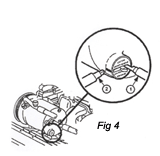
Using a utility knife, cut through the label for access to the setscrew (1). See Figure 4.
Using a permanent ink marker, make a mark on the A/C compressor to indicate the current position of the setscrew in relation to the compressor rear head (2).
Using a large blade screwdriver, turn the setscrew 1/4 turn clockwise as viewed from the rear of the compressor. See Figure 5.
Warning: Do not turn the setscrew on the back of the A/C compressor counterclockwise. The A/C system is under pressure, and turning the setscrew counterclockwise could cause the setscrew and/or the hot refrigerant/oil mixture to be discharged. The refrigerant/oil mixture can cause burns and/or bodily injury.
Caution: Do not turn the setscrew more than 1/4 turn clockwise. Adjusting the set point changes the pressure at which the A/C compressor goes to minimum displacement. Increasing the adjustment beyond 1/4 turn clockwise will not make the system colder and could reduce A/C system performance at higher ambient temperatures.
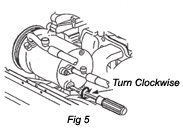
Start the engine and check that the A/C system is functioning normally.
That’s all there is to it. A simple turn of the old A/C compressor set point adjustment screw, and your customer’s A/C is blowing colder than the winds of Saturn. Well, almost.
Written by ALLDATA Technical Editor, Rich Diegle. Rich is an Advanced Engine Performance Certified and ASE Master Technician with 22 years of dealership and independent shop experience.




